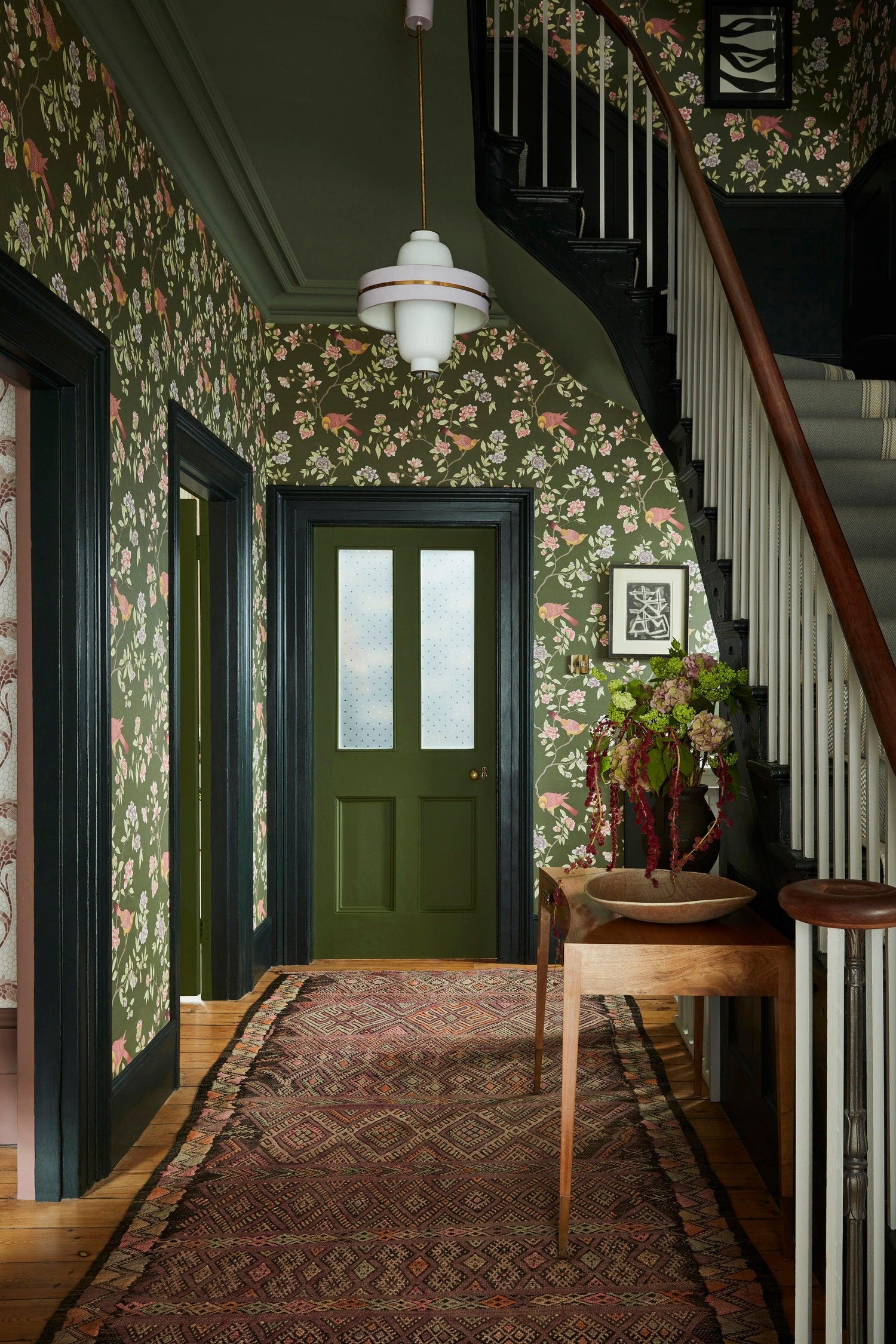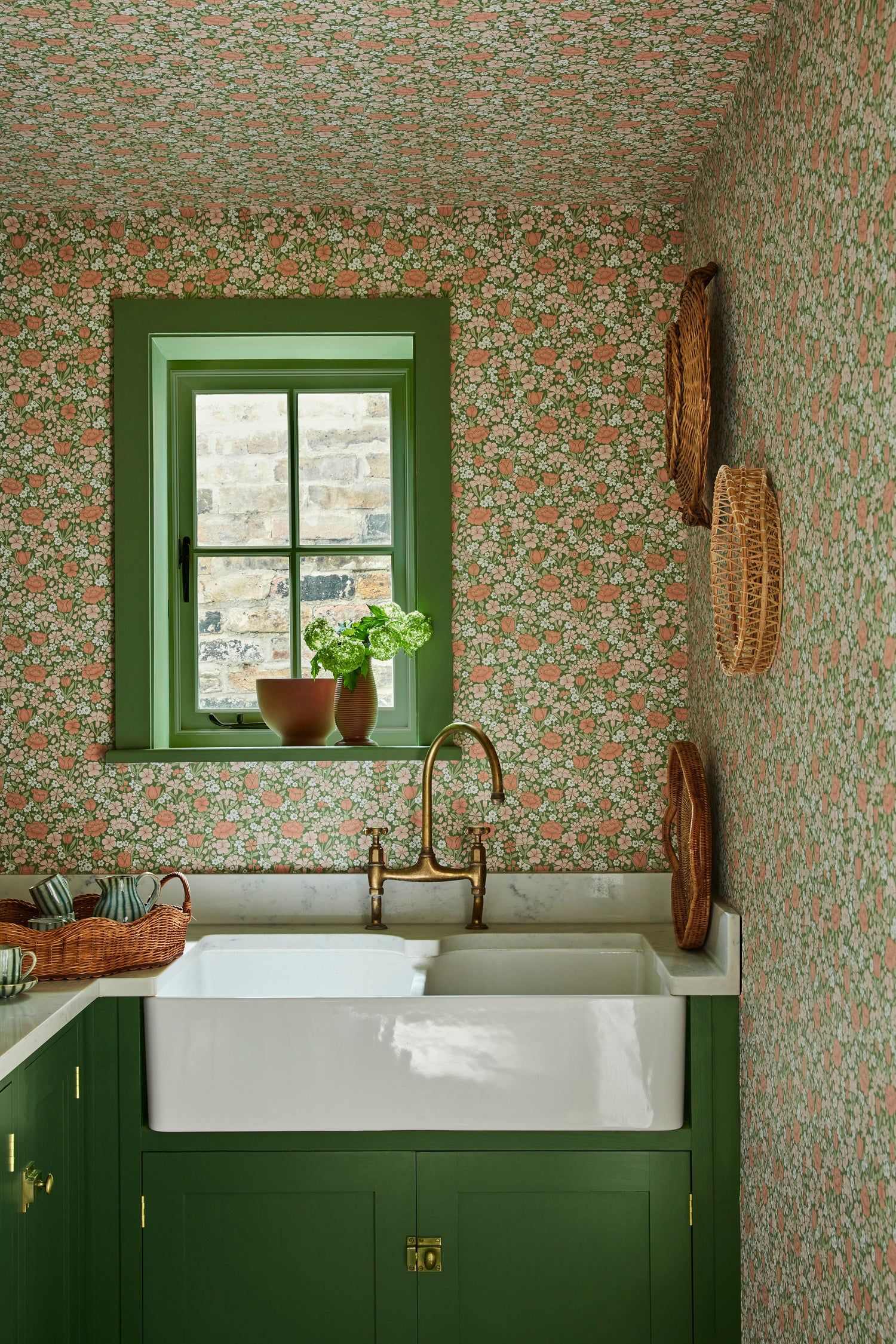
Die vielseitige Kollektion umfasst historische Tapetendesigns, die für die Verwendung in heutigen Interieurs angepasst und farblich neu gestaltet wurden. Jedes Design basiert auf originalen Mustern, die in mehreren historischen Liegenschaften des National Trust gefunden wurden. Zudem wurde einem Design aus dem Archiv von Little Greene eine neue Farbstellung verliehen. Somit repräsentiert diese Kollektion über 250 Jahre britische Dekorationsgeschichte, die sich durch den gekonnten Einsatz von Farben bestens für die Verwendung für zeitgenössisches Interior Design eignet.
Produziert mit verschiedenen Druckmethoden, von traditionellem Oberflächendruck bis hin zu hochmodernen digitalen Techniken, umfasst die Kollektion eine Vielzahl an Motiven wie exotische Vögel, stilisierte Blumen und verschlungene Pfade, sowie verspielte Blumendrucke und großformatige tropische Wandbilder.

“Mit dem National Trust zusammenzuarbeiten, um diese unglaublichen historischen Designs zu entdecken und aufzubereiten, ist eine wirkliche Ehre für uns bei LITTLE GREENE. Die Designs in dieser Kollektion gehen zurück bis in das Jahr 1770, wirken aber noch immer zeitgemäß. Das Colorieren dieser historischen Muster in den neuen Farbvarianten und das Präsentieren in modernen Räumen stellt sicher, dass sie uns noch viele Jahre erfreuen können.” LITTLE GREENE Kreativdirektorin Ruth Mottershead.
Mit dem Erlös aus dem Verkauf jeder LITTLE GREENE Tapetenrolle wird die wichtige Arbeit des National Trust unterstützt, der sich um 500 Orte in Großbritannien kümmert, darunter 780 Meilen Küstenlinie, historische Stätten, 250.000 Hektar Land und Grünflächen, um das historische Erbe zu bewahren.
Hier stellen wir dir die verschiedenen Tapeten der Kollektion vor

Aderyn – Erddig ca. 1770
Im späten 18. Jahrhundert war Erddig in Wales das Familienhaus von Philip Yorke und seiner Frau Elizabeth. Sie dürften diese handbemalte chinesische Tapete, die aufwendig mit exquisiten Vögeln und Blumen verziert ist, für das Gästezimmer des Anwesens ausgewählt haben. Das Originalgemälde war zart und filigran gestaltet mit Vögeln, die paarweise auftauchten – ein subtiler Hinweis auf das chinesische Konzept der Verbindung von Gegensätzen (Yin und Yang). Die hier gezeigten Blumen umfassen Magnolien (die weibliche Schönheit symbolisieren) und Pfingstrosen (die Erhabenheit symbolisieren).
LITTLE GREENE wallpaper - Aderyn - Arquerite Dark
In the late 18th century, Erddig in Wales was the family home of Philip Yorke and his wife Elizabeth. You may have chosen this hand-painted Chin...
View full detailsLITTLE GREENE wallpaper - Aderyn - China Clay
In the late 18th century, Erddig in Wales was the family home of Philip Yorke and his wife Elizabeth. You may have chosen this hand-painted Chin...
View full detailsLITTLE GREENE wallpaper - Aderyn - French Grey
In the late 18th century, Erddig in Wales was the family home of Philip Yorke and his wife Elizabeth. You may have chosen this hand-painted Chin...
View full detailsLITTLE GREENE wallpaper - Aderyn - Hicks Blue
In the late 18th century, Erddig in Wales was the family home of Philip Yorke and his wife Elizabeth. You may have chosen this hand-painted Chin...
View full detailsLITTLE GREENE wallpaper - Aderyn - Olive Colour
In the late 18th century, Erddig in Wales was the family home of Philip Yorke and his wife Elizabeth. You may have chosen this hand-painted Chin...
View full details
Capricorn – Frühes 19. Jahrhundert
Dieses Wandgemälde ist von historischen Wandpaneelen aus dem frühen 19. Jahrhundert von Velay und Zuber inspiriert und wurde von Hand neu gemalt, um die idealisierte und stereotypische Darstellung von Landschaften wiederzugeben, die damals als romantisch oder exotisch galten. Verteilt über drei Bahnen zeigt diese zeitgenössische Interpretation ein üppiges Panorama mit Affen und tropischen Vögeln.
LITTLE GREENE wallpaper - Capricorn - Blush
This lush mural is inspired by historic early 19th century wall panels by Velay and Zuber and has been repainted by hand. The idealized and ster...
View full detailsLITTLE GREENE wallpaper - Capricorn - Boringdon
This lush mural is inspired by historic early 19th century wall panels by Velay and Zuber and has been repainted by hand. The idealized and ster...
View full detailsLITTLE GREENE wallpaper - Capricorn - Etruria
This lush mural is inspired by historic early 19th century wall panels by Velay and Zuber and has been repainted by hand. The idealized and ster...
View full detailsLITTLE GREENE wallpaper - Capricorn - Portland Stone
This lush mural is inspired by historic early 19th century wall panels by Velay and Zuber and has been repainted by hand. The idealized and ster...
View full details
Bamboo Floral – Kingston Lacy Estate ca. 1790
Dieses Design basiert auf kleinen bemalten Abschnitten chinesischer Tapeten, die auf dem Kingston Lacy Anwesen in Dorset gefunden wurden. Über diese Fragmente ist wenig bekannt und es ist unklar, ob das Muster tatsächlich im Haus selbst verwendet wurde. Importierte chinesische Tapeten waren im 19. Jahrhundert in Herrenhäusern äußerst beliebt, und die Tapezierer schnitten individuelle Elemente aus und setzten sie nebeneinander auf Paneele, um der Tapete einen panoramaartigen Anschein zu verleihen. Es ist durchaus möglich, dass die gefundenen Fragmente von diesem Prozess übriggeblieben sind.
LITTLE GREENE Wallpaper - Great Ormond St - Galette
The colorful, vibrant parrot motif was discovered in a ground floor chamber of an early 18th century terraced house opposite Great Ormond Street C...
View full detailsLITTLE GREENE wallpaper - Bamboo Floral - Blue Verditer
The design of the Bamboo Floral wallpaper is based on small painted sections of Chinese wallpaper found on the Kingston Lacy estate in Dorset. Im...
View full detailsLITTLE GREENE wallpaper - Bamboo Floral - Heat
The design of the Bamboo Floral wallpaper is based on small painted sections of Chinese wallpaper found on the Kingston Lacy estate in Dorset. Im...
View full detailsLITTLE GREENE wallpaper - Bamboo Floral - Leather
The design of the Bamboo Floral wallpaper is based on small painted sections of Chinese wallpaper found on the Kingston Lacy estate in Dorset. Im...
View full detailsLITTLE GREENE wallpaper - Bamboo Floral - Mambo
The design of the Bamboo Floral wallpaper is based on small painted sections of Chinese wallpaper found on the Kingston Lacy estate in Dorset. I...
View full details
Spring Flowers – Standen House ca. 1910
Standen House in West Sussex ist eines der besten Beispiele für ein Arts & Crafts Haus in England, entworfen von Philip Webb mit Interieurs von William Morris. Dieses von einer Vielzahl von Frühlingsblüten geprägte Design zeigt, wie Designer der damaligen Zeit von Blumen und Blättern inspiriert waren und wie sie diese Formen stilisierten, um die Natur ins Innere zu holen. Das erhaltene Original dieser Tapete ist in einer monochromen Farbvariante in Blau und Weiß gehalten, aber sonst ist wenig über die Geschichte dieses speziellen Designs bekannt.
LITTLE GREENE wallpaper - Spring Flowers - Blush
Standen House in West Sussex is one of the finest examples of an Arts & Crafts house in England, designed by Philip Webb with interiors designed...
View full detailsLITTLE GREENE wallpaper - Spring Flowers - Bombolone
Standen House in West Sussex is one of the finest examples of an Arts & Crafts house in England, designed by Philip Webb with interiors designed ...
View full detailsLITTLE GREENE wallpaper - Spring Flowers - French Grey
Standen House in West Sussex is one of the finest examples of an Arts & Crafts house in England, designed by Philip Webb with interiors designed...
View full detailsLITTLE GREENE wallpaper - Spring Flowers - Garden
Standen House in West Sussex is one of the finest examples of an Arts & Crafts house in England, designed by Philip Webb with interiors designed...
View full detailsLITTLE GREENE wallpaper - Spring Flowers - Juniper
Standen House in West Sussex is one of the finest examples of an Arts & Crafts house in England, designed by Philip Webb with interiors designed...
View full details
Burges Butterfly – Knightshayes Court, Devon ca. 1878
„Burges Butterfly” ziert die Wände des Boudoirs des Landhauses Knightshayes Court in Devon und wurde von William Burges (1827-1881), einem Architekten und Designer der Neugotik, entworfen. Es steht in deutlicher Verbindung mit einer anderen Tapete aus derselben Zeit, der „Burges Snail”. Genau wie „Burges Snail“ hat das Design keine tiefere historische Verbindung zum Knightshayes Court, dem einzigen vollständigen Herrenhaus von Burges, sondern ist ein weiteres Burges-Muster, das von seiner Leidenschaft für die Architektur und Kunst des mittelalterlichen Europas und des asiatischen Designs beeinflusst ist.
LITTLE GREENE wallpaper - Burges Butterfly - French Grey
“Burges Butterfly” adorns the walls of the boudoir at Knightshayes Court country house in Devon and was designed by William Burges (1827-1881), a...
View full detailsLITTLE GREENE wallpaper - Burges Butterfly - Garden
The “Burges Butterfly” wallpaper features the delightful butterflies that adorn the walls of the boudoir of the Knightshayes Court country house ...
View full detailsLITTLE GREENE wallpaper - Burges Butterfly - Hicks Blue
The Burges Butterfly wallpaper adorns the walls of the boudoir of Knightshayes Court in Devon and was designed by William Burges (1827-1881), a G...
View full detailsLITTLE GREENE wallpaper - Burges Butterfly - Masquerade
The Burges Butterfly wallpaper adorns the boudoir walls of Knightshayes Court in Devon and was designed by William Burges (1827-1881), a Gothic R...
View full detailsLITTLE GREENE wallpaper - Burges Butterfly - Slaked Lime
The Burges Butterfly wallpaper adorns the boudoir walls of Knightshayes Court in Devon and was designed by William Burges (1827-1881), a Gothic ...
View full details
Mosaic Trail – Felbrigg Hall ca. 1885
Ein eleganter Blumenweg mit raffinierter Farbvariation – über die Geschichte dieser Tapete ist wenig bekannt, aber es stammt wahrscheinlich aus dem Ästhetizismus des späten 19. Jahrhunderts. Das Muster imitiert ein gefliestes Mosaik und erzielt einen charmanten, lockeren Abschluss mit subtilen Schattierungseffekten.
LITTLE GREENE wallpaper - Mosaic Trail - Aquamarine
An elegant floral path with sophisticated color variation - little is known about the history of this wallpaper, but it probably dates back to l...
View full detailsLITTLE GREENE wallpaper - Mosaic Trail - Blush
An elegant floral path with sophisticated color variation - little is known about the history of this wallpaper, but it probably dates back to l...
View full detailsLITTLE GREENE wallpaper - Mosaic Trail - Etruria
An elegant floral path with sophisticated color variation - little is known about the history of this wallpaper, but it probably dates back to l...
View full detailsLITTLE GREENE wallpaper - Mosaic Trail - Slaked Lime
An elegant floral path with sophisticated color variation - little is known about the history of this wallpaper, but it probably dates back to l...
View full details
Ditsy Block – Felbrigg Hall ca. 1900
Diese attraktive Blumentapete wurde in Felbrigg Hall in Norfolk gefunden und ist eine der interessantesten Tapeten des Anwesens. Der
Fundort macht neugierig, denn die Tapete stammt aus einem Dachgeschoss, das vermutlich ein ehemaliges Personalzimmer war – ein ungewöhnlicher Ort, um eine kunstvolle Tapete aufzuhängen. Die Tapete wurde wahrscheinlich im Holzblockdruckverfahren hergestellt und das Original weist am oberen Rand des Musters eine gemalte Flechtung auf, die an Damastmobiliar erinnert.
LITTLE GREENE wallpaper - Ditsy Block - Bombolone
This attractive floral wallpaper was found at Felbrigg Hall in Norfolk and is one of the estate's most interesting wallpapers. The location is c...
View full detailsLITTLE GREENE wallpaper - Ditsy Block - Bone China Blue
This attractive floral wallpaper was found at Felbrigg Hall in Norfolk and is one of the estate's most interesting wallpapers. The location is c...
View full detailsLITTLE GREENE wallpaper - Ditsy Block - Carmine
This attractive floral wallpaper was found at Felbrigg Hall in Norfolk and is one of the estate's most interesting wallpapers. The location is c...
View full detailsLITTLE GREENE wallpaper - Ditsy Block - Green Verditer
This attractive floral wallpaper was found at Felbrigg Hall in Norfolk and is one of the estate's most interesting wallpapers. The location is c...
View full detailsLITTLE GREENE wallpaper - Ditsy Block - Masquerade
This attractive floral wallpaper was found at Felbrigg Hall in Norfolk and is one of the estate's most interesting wallpapers. The location is c...
View full detailsLittle Greene im Vintage Kontor
Wir sind offizieller Händler von Little Greene.
Bei uns könnt ihr die komplette Kollektion an Tapeten erhalten.
Entweder ihr bestellt online über unseren Shop oder ihr kommt bei uns vorbei und lasst euch ausgiebig von unserem Fachberater inspirieren.
Wir haben für euch alle Tapeten - Musterbücher im Laden, ebenso wie die Sample Pots der Farbkollektion von Little Greene.
Einen Kaffee in der schönen Atmosphäre unseres Vintage Shops gibt’s auch noch dazu.




































